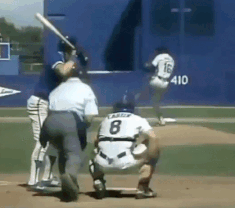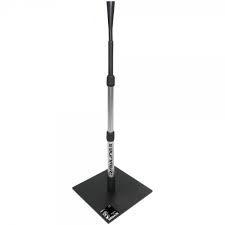In response to my last article (which you can read here) I got several questions on whether tee transfers to in-game production and whether it is worth doing. As some of you may know, I personally have very strong feelings on this topic as it relates to my own swing. I have not found the tee to be useful or helpful in building a swing that will compete against the demands we see in competition. In fact, I never use a tee. Instead, I go through a movement program to warm-up, specific to what I am working on in the swing. Following that I immediately go straight into whatever I’m working on that day. With that being said, I am not about to say one of the most-used tools in baseball is worthless. Let’s dig into it a little bit deeper.
To start off, we need to make the distinction that hitting off a live pitcher in a game is an open skill. What is an open skill? An open skill is simply an activity in which the stimuli/environment is constantly changing and we have to adjust to it to complete the task. In hitting, the external stimuli is the pitch. We need to be able to start our swing and then make small adjustments based upon what the pitch is, where it is, the movement it has, etc in order to execute the desired movement.
Conversely, we have closed skills. These are skills in which the desired result is predetermined and no external stimuli is going to affect it. For example: delivering a pitch, a dance routine, a pushup, etc. Going further, we see that using a tee is turning the act of hitting into a closed skill. The ball is in a predetermined position. Once you start your swing your intention is set and nothing is going to affect you as you execute that skill. Is this conducive to helping us hit live pitching?
(Is tee work going to prepare you to face this?-credit to the awesome @PitchingNinja for this gif)
In simple terms, your use of the tee depends on several factors:
- Is it a part of your everyday routine already?
- Where are you at in your development?
- What you are working on that day
1) If you are already an advanced/older player and you have been using the tee your whole life, it may not be the best idea to abruptly take it away. As a player I can relate to some things I absolutely have to do to feel like I can be at the top of my game. Motor learning, skill type, etc aside, the player needs to be at the top of his game mentally. If taking the tee away is going to disrupt that, it is not worth it.
2) Each player is at a different point in terms of their development and where their swing is at. For a player who has some major mechanical issues the tee can be a useful tool. It will take away the pressure to hit a moving ball and allow them to focus all of their attention on the swing itself. For the player who has a solidified swing and only needs minor adjustments, I question the purpose of the tee beyond a comfort thing. It really is a completely different skill than hitting a live pitch. If it is used solely as a warm-up tool, I would argue there are other more productive routes to accomplish that. However that is something you need to discuss with each individual player. It will differ in each case.
3) Bumping off the last point, the tee can be useful if you are using a training day to work on your swing. In reality, everyday you swing a bat you are refining your mechanics. However the tee can be a good way to isolate that.
Problems I Have With the Tee
This is the potion of the article where I get to let my disdain for the tee known. Having said the tee can be a useful tool for some, I now feel better about ranting on it in this portion ;).
Lack of Context
There is no guarantee that your tee swing is going to transfer to in-game production. There are players who bomb the ball in BP, but can’t do it in games. BP is much closer to a game situation than the tee. Do we really think hitting a ball hard off a tee is any indication a player will be able to do that when it matters, between the lines? Sure if you are a literal athletic freak like Giancarlo Stanton or Mike Trout that might work for you. You may have enough proprioception (essentially body awareness) to make that happen. The stark reality is that anyone who is reading this article is not that guy. Instead, you may be a good, not great, athlete. This is not a crack at your athletic ability. But we must understand that just because pro player X trains this way, that does not mean we can do the same and be as successful as player X. They have a different set of skills and abilities and we must recognize that and train to compensate for it.
Overuse
“I take 400 swings a day… off a tee in my basement”. Believe me, I’ve literally been this guy before. And when I say overuse, I do not mean that as 400 swings a day is too much. I mean it in the sense that taking ALL 400 swings off a tee is pointless and overuse of the tee. Once again, context of timing and adjustments you will need to make in real games is lost. I love players who will take the time and effort to put several hours of work into the skill of hitting everyday. Nothing hurts more than when that player is putting in his work in the wrong area. Don’t just practice, get better at the actual skill you need to get better at. Just “working hard” is pointless and is eyewash.
Decision-Making and Adjustments
Although this goes along with my first point, I wanted to point this out separately: A huge chunk of hitting successfully is predicated on being able to make a split second, unconscious decision on how to sequence your body to get to the baseball optimally. The tee is not going to help you with that! To put it in perspective, think about another sport that requires split-second decision making: soccer. Do you think Brazil’s top soccer players are built by repeatedly taking the same shot over and over until their foot goes numb? No. Instead, it seems just the opposite. As was revealed in Daniel Coyle’s book The Talent Code, Brazil’s soccer players are built on a game called futsal. What is it? Soccer on steroids. The court is smaller, the ball is heavier, the game is more concentrated. Players are constantly being pressured and attacked by the opposition, forcing them to make quick and rapid decisions. They don’t have time to think about it. They learn to make these decisions based on instinct through years of training. By the time they step foot on a real soccer field (Coyle indicated that it was normally around 12-13 years of age), the game seemed incredibly slow for them. I won’t go into detail on how we can apply this to baseball in this article, but I’m sure you can imagine where my mind is headed with this…
Conclusion and How to Apply It
My purpose with this article was not to destroy the batting tee. I think it can be a useful tool in the right context, but I often see it misused. Here is a quick recap on when and who the tee is suitable for and some ideas on how to use it to your benefit:
- Early stages of a swing change: takes away pressure to hit the pitch
- Warm-up (if it is already a solidified part of your routine)
- If you have no friends for the day and can’t stand not swinging (only partially joking ;))
Awesome. As with most things, the tee is not the devil but it is not the best thing on planet earth either. Use it as a tool, not as your entire training program, and everything will be okay.
Congrats! You made it to the end! Whether you agree or disagree I would love to hear from you. Either leave me a comment below or you can shoot me an email at brady@dacbaseball.com.
